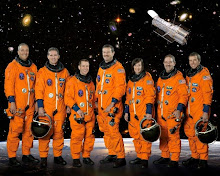An Orbiting Partnership is Born - Apollo-SoyuzOn July 17, 1975, something momentous happened: two Cold War-rivals met in space. When their respective spacecraft rendezvoused and docked, a new era of cooperative ventures in space began.

For more than a decade, American astronauts and Russian cosmonauts have been regularly living and working together in Earth orbit, first in the Shuttle-Mir program, and now on the International Space Station. But, before the two Cold War-rivals first met in orbit in 1975, such a partnership seemed unlikely.
Since Sputnik bleeped into orbit in 1957, there had indeed been a Space Race, with the U.S. and then-Soviet Union driven more by competition than cooperation. When President Kennedy called for a manned moon landing in 1961, he spoke of "battle that is now going on around the world between freedom and tyranny" and referred to the "head start obtained by the Soviets with their large rocket engines."But by the mid-70s things had changed.
The U.S. had "won" the race to the moon, with six Apollo landings between 1969 and 1972. Both nations had launched space stations, the Russian Salyut and and American Skylab. With the space shuttle still a few years off and the diplomatic chill thawing, the time was right for a joint mission.
The
Apollo-Soyuz Test Project would send NASA astronauts Tom Stafford, Donald K. "Deke" Slayton and Vance Brand in an Apollo Command and Service Module to meet Russian cosmonauts Aleksey Leonov and Valeriy Kubasov in a Soyuz capsule. A jointly designed, U.S.-built docking module fulfilled the main technical goal of the mission, demonstrating that two dissimilar craft could dock in orbit. But the human side of the mission went far beyond that.
Image Credit: NASA
Nick
SPACEBOOSTERS Online Store

 (09/03/2008) --- CAPE CANAVERAL, Fla. – Space shuttle Atlantis stands ready in the Vehicle Assembly Building at NASA’s Kennedy Space Center for the pending rollout to Launch Pad 39A. Visible behind Atlantis (upper left) is the external fuel tank. The Sept. 2 rollout date was postponed due to Tropical Storm Hanna’s shift to a northern track. Managers are closely following Hanna to determine when would be the best time this week to move space shuttle Atlantis to its launch pad. The tentative rollout time is 10 a.m. Sept. 4, depending on the track Hanna follows along the Florida coast. Atlantis is scheduled to launch on the STS-125 mission to service NASA’s Hubble Space Telescope. Launch is targeted for Oct. 8.
(09/03/2008) --- CAPE CANAVERAL, Fla. – Space shuttle Atlantis stands ready in the Vehicle Assembly Building at NASA’s Kennedy Space Center for the pending rollout to Launch Pad 39A. Visible behind Atlantis (upper left) is the external fuel tank. The Sept. 2 rollout date was postponed due to Tropical Storm Hanna’s shift to a northern track. Managers are closely following Hanna to determine when would be the best time this week to move space shuttle Atlantis to its launch pad. The tentative rollout time is 10 a.m. Sept. 4, depending on the track Hanna follows along the Florida coast. Atlantis is scheduled to launch on the STS-125 mission to service NASA’s Hubble Space Telescope. Launch is targeted for Oct. 8. 




























 Photo Credit:NASA
Photo Credit:NASA










